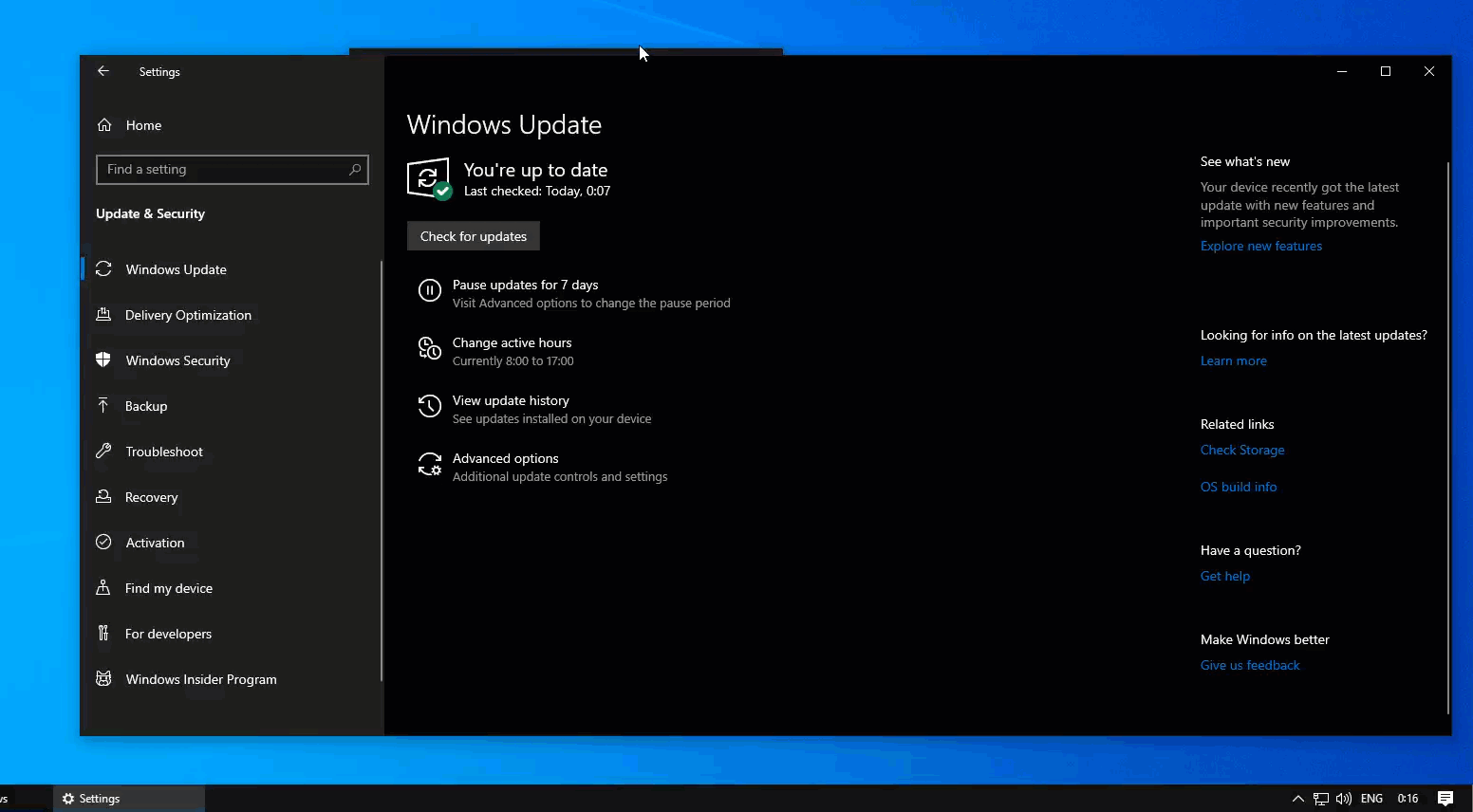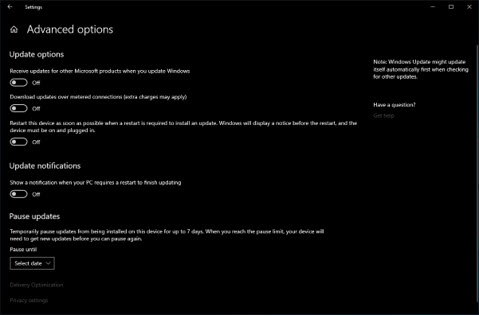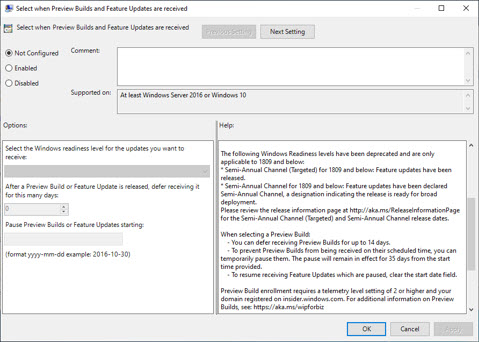Newsletter Archives
-
Is there a way to cheat Pause Update?

We just got an interesting anonymous post, from someone who may have found a way to Pause Updates in Win10 1903 and 1909 beyond the allowed 35-day limit.
(For those who haven’t been following closely, we’ve ascertained that the advice I gave in Computerworld last week isn’t quite correct: You can click on “Pause updates for seven more days” up to 35 days, total. So if you clicked on “Pause updates for 7 more days” twice last week, you can still click it more times this week. It’s just that the total paused updates, starting on the day you first paused updates, maxes out at 35.)
Here’s the anonymous post:
I am using Windows 10 v1903 x64 Home Edition on my laptop and updated patches until Jan 2020 via Windows Update back in Jan 2020. Checked on Settings > Update & Security > Windows Update today and pause update was set until 26 Feb 2020. Hit Advanced Options and maximum pause update can be extended to 27 Feb 2020 i.e. only by 1 day.
Tinkered by hitting resume updates and Windows Update started it’s checking run. Once the list of available updates are shown and then they are set to “Pending Download” Status. Interrupted the Windows Update process by hitting “Airplane Mode” i.e. cutting the internet connection.
Checked on Advanced Options again and the maximum pause update is now until 29 Mar 2020. Extended the pause update accordingly. Checked on View Update History indicated those listed patches installation as failed.
Note : My Internet connection setting is on “Metered Connection”.
The technique doesn’t seem to be restricted to Home – it appears to work on Pro, too.
In short, if you hit the end of your 35 day Pause, then set your internet connection to Metered, then click Resume Updates (and, possibly, disconnect from the internet at that point), the 35-day meter gets reset.
Very clever, if it works.
Can anyone out there confirm?
-
Defer updates, Pause updates, Delay updates, and the big unknown of Win10 1909
Yes, there’s a difference between Defer updates and Pause updates. But that’s just the tip of the micro-plastic infused iceberg.
The main sticking point: Win10 still has both concepts floating around, they conflict, and we don’t have any idea how the conflicts are being resolved — a problem that’s going to get worse with the release of Win10 version 1909, which doesn’t follow the Defer, Pause, push, pull or prod rules.
Details in Computerworld Woody on Windows.
Thx @b, @PKCano
-
The ability to defer updates in Win10 version 1903
We still don’t know what defer options Win10 version 1903 will have. So understand, right up front, that this is speculation.
Last week I raged about the apparent demise of deferral options in Win10 1903 Pro. Ends up, my vituperations were premature. I was working with a copy of the Win10 1903 beta that had been updated repeatedly. One theory has it that, once you click on Check for updates, the beta version of Win10 1903 changes its options. Be that as it may, people who have installed Win10 1903 from the latest ISO versions are seeing something different. @teroalhonnen was the first to nudge me and say that what I saw is not what everyone sees.
Meh.
Leopeva64, posting on Reddit and on Tenforums, has carefully constructed clean versions of Win10 version 1903, Pro and Home. He managed to install both without enrolling in the Insider program.
Here’s what Pro looks like, in the latest latest test version:

You can see a video on Reddit here.
Here’s what Home looks like:

You can see a much more legible video on Reddit here.
If Microsoft ships Win10 version 1903 with the current arrangement, Win10 Home users will be able to Pause updates for 35 days. That’s tremendous – it gives you the ability to push off patches until the next month’s cumulative update appears. Win10 Pro users lost the ability to choose channels (SAC, SAC-T, Current Branch for Business, whatever), but the ability to defer “feature updates” (which is to say, version changes) for 200 days or more will help.
Maybe Win10 1903 will be worthwhile after all….
-
Win10 1903 Pro Windows Update advanced options — WUH?
Somebody strap me down. I’m about to have a foaming-at-the-mouth episode. The kind only Windows can provide.
First, an apology. I’ve been very busy swallowing a whale and haven’t looked at the latest beta test builds of Win10 version 1903 — the version that’s due to go RTM any day now. The builds tend to get very boring at this point — all bug fixes and no interesting new features.
Early this morning, I was looking at Windows Update in the latest beta build of Win10 version 1903 Pro. And I’m about to hit the roof.
Last time I looked, which was in mid-February, Windows Update had an Advanced Options pane that looked like this:

At the time I noted that MS had banished the “Choose when updates are installed” selection, which is where you specify “Semi-Annual Channel (Targeted)” or “Semi-Annual Channel”. That’s how you tell Windows 1809 update to keep its mitts off your machine until a new version is declared Ready for Business. Of course, we know that the terminology has changed, and right now we don’t have any idea when/if Microsoft will ever declare Win10 1809 ready for business. That’s a different can of worms, which Susan Bradley talked about in her Monday AskWoody Plus Newsletter 16.8.0 column.
But at least we had the “feature update deferral” setting, which is something.
I took that screenshot on Feb. 15.
Early this morning, while poking around the latest beta release, I found this Advanced Options dialog:

What in the chicken-fired HAIL is going on here?
All of the old deferral settings are gone, replaced by a stunted “Pause for 7 days” option.
I was expecting that kind of neutering on Win10 1903 Home. Paul Thurrot warned us about it in a Premium article in January:
It is now possible—or, will be possible when Windows 10 19H1 ships—on Windows 10 [Home] to pause Windows Updates for 1 to 7 days.
I filed that in my mind’s “good to know but not terribly helpful” bucket. While this seven day max “Pause” button is better than what Win10 Home has now — which is to say, diddly squat — it’s little more than a fig leaf for the horribly flawed Windows patching juggernaut. As I said in Computerworld last month:
The current beta test version of the next (“19H1” or “1903”) version of Win10 Home includes the ability to Pause updates for seven days. While that’s certainly a step in the right direction, it doesn’t help much in the real world:
- You can only Pause once, and only for seven days
- You can’t Pause again without accepting all backed-up updates in the interim
- You have to know in advance that a bad update is coming down the pike – there’s no warning
All of which makes Win10 Home “Pause updates” a really nifty marketing setting (“Look! You can pause updates in Win10 Home!”) that’s basically useless. Unless you’re Carnac the Magnificent.
Now, unless I missed something obvious (please tell me if I did!), it looks like Win10 Pro is going to get this same 7-day Pause Updates fig leaf, and the real settings are only accessible in Group Policy (type gpedit.msc, hit Enter, navigate to Computer Configuration >Administrative Templates > Windows Components > Windows Update > Windows Update for Business).

Note that “Semi-Annual Channel” has been neutered — it takes gall to put those settings in a folder called Windows Update for Business — but at least the feature deferral setting is still there.
Soooooo…. Is this how 1903 will ship? What happened in the past month? What did I miss? Somebody please help before I start going into paroxysms of Windows Update angst.
Again.
-
Hidden update throttling screen in new Win10 Creators Update beta build 15046
UPDATE: Microsoft has responded to the questions I posed below. Please see their responses interspersed with the questions.
Microsoft’s post on Win10 Creators Update for today talks about a new, giant-sized notification that should appear when there’s an update waiting. It looks like this:
There are also some tiny changes to the “Schedule the restart” dialog. There’s a rehash of the “Choose privacy settings for your device” sequence during installation. I don’t see any changes from the setup sequence I talked about six weeks ago.
Other than that, there isn’t much there… there.
In particular I was hoping MS would talk about the hidden screen in Win10 beta build 15046 that I discussed this morning in InfoWorld.
I don’t see hide nor hair about that dialog. It’d be a real improvement, if it makes the final cut for Creators Update. See my InfoWorld Woody on Windows article for details.
My questions about the definitions of those settings continue. In particular:
- How do the “Pause Updates” and “Choose when updates are installed” sections interact? Does one over-ride the other? (Note that the Group Policy associated with this setting has two different options, one for version changes, er, feature updates, and another for “quality” updates.)
Microsoft’s explanation:
Deferral is the first concept – this allows you to defer the installation of both Feature and Quality updates: Feature updates for up to 365 days, and Quality Updates for up to 30 days.
Pause enabled via the UX does indeed over-ride – it stops all updates but Defender from being applicable for the amount of time you set.
Pause enabled via policy can be differentiated: For example you can pause a feature update while allowing quality updates to continue.
- If you choose to wait for Current Branch for Business (always a good idea if you don’t want to be an unpaid beta tester), does the “feature update… deferred for this many days” setting kick in after the version hits CBB?
Microsoft’s explanation:
The deferral period is based on your branch selection, and the time starts when that branch is released.
- What, exactly, is a “quality” update? Obviously “quality” includes cumulative updates. But does it include posted-but-not-delivered hotfixes like 14393.577 and 14393.729? What about servicing stack updates? Drivers (especially drivers delivered as updates for Surface Book and Surface Pro machines)? Ad-hoc security patches like the just-released IE and Edge patches? MSRT updates? .NET patches?
Microsoft’s explanation:
Feature updates are updates that include additional functionality or features – The Anniversary Update (1607) and the upcoming Creators Update are examples of Feature Updates. Quality Updates do not include new features – these are fixes to existing features that include security updates, driver updates, bug fixes, etc. Here is a good explanation of the various updates within Windows as a Service.
My questions no doubt sound pedantic at this point. Inside baseball. I assure you, in a few months, many people will be scrambling for answers.
Let’s hope Microsoft fills in some blanks before the offal hits the fan.
I want to thank the team at Microsoft for clarifying these points. I still have some questions (what about hotfixes? drivers for Surface?), but it’ll all become clear as we watch the new method unfold.
By the way, I didn’t ask – and haven’t heard – if the hidden dialog will become part of the final Creators Update.
-
Newly revealed dialogs show how Windows Update can be stalled in the next version of Win10
Ed Bott, who’s become the voice of Microsoft, has just posted a couple of interesting screen shots and an explanation of how Win10 Pro/Enterprise users will be able to delay forced updates in the next version of Win10 – the “Creators Update” due next month.
You should take the article as gospel truth.
The long and short of it: Although the dialogs don’t appear in the current beta build 15042, at some point in the future Microsoft will release a build of Win10 version 1703 that lets you control when cumulative updates are installed.
One of the dialogs shown in the article gives you the ability to Pause updates “for up to 35 days” by sliding a switch. Although it isn’t stated explicitly, apparently “updates” in this case refers to both cumulative updates and version changes. It also isn’t clear why the slider says “up to” – they’re either paused or they aren’t, I would guess.
The other dialog, which appears to overlap the “pause updates” dialog, gives you three independent choices:
- Wait for a version to be declared Current Branch for Business before it’s installed on your computer (the choice that keeps you out of the “unpaid beta tester” category).
- Defer a version change for up to a set number of days. Bott implies that you’ll be able to defer a version change for up to 365 days after it reaches CBB level.
- A very poorly worded setting “A quality update includes security improvements. It can be deferred for this many days” with a drop-down box that apparently runs up to 30 days. I’m assuming a “quality” update is a cumulative update. I have no idea how other Win10 updates – servicing branch changes, drivers (particularly for Surface machines), ad-hoc security patches like the just-released IE and Edge patches, and any other security patches that aren’t rolled into cumulative updates — will be affected.
There’s also no indication of how the “Pause updates for up to 35 days” slider interacts with (replaces?) the “defer quality updates up to 30 days” setting. Are they additive? Do they cover the same patches? Why does one max out at 30 days, and the other sits fixed at 35 days?
We haven’t seen the dialogs yet. We haven’t seen the group policy settings that conform to (conflict with?) the settings. And we don’t know when we’ll get any or all of the above, except they’ll presumably appear before Creators Update hits RTM.
-
Win10 Home appears to be getting the “Pause Updates” setting
I wouldn’t have believed it if I didn’t just verify it myself.
Windows 10 beta build 15002 (and 15007) Home have the “Pause Update” capability, which freezes updates for 35 days (details still not fully known – see http://www.infoworld.com/article/3155912/microsoft-windows/windows-10-beta-build-15002-brings-real-improvement.html).
We knew it was in Pro and Enterprise. But it’s also in Home.
so why did they state Pro SKU and higher
?
— Barb Bowman
(@barbbowman) January 13, 2017







